After our post on Kimchi (May 15, 2011) we decided to start making our own fermented vegetables. Foods are always healthier when made at home, and you can adjust the ingredients to fit your taste.
I’m happy to say it’s been a big success. Our kimchi is tastier than store-bought kimchi, probably much healthier, and we’re eating more of it.
We’re making a number of different varieties, including white radish kimchi and cucumber and carrot kimchi. The methods are essentially the same, so we’ll just show you the traditional Korean cabbage kimchi.
Preparing the cabbage
We used about 5 pounds (2.3 kg) Napa cabbage, about 1½ heads. A head looks like this:
The outer layer usually is dirty or has some damage, so we discard that. We also cut out the stem.
In the traditional methods, when kimchi was made at harvest and was meant to store vegetables through the winter, the head of cabbage would be kept whole. However, for household use it’s best to cut it immediately into bite-size pieces. We do that by cutting the head in half and then cutting cross-wise:
The next step is to salt and dehydrate the cabbage. The salt helps draw water out of the cabbage, preventing the kimchi from becoming watery or soupy, and also helps sterilize the cabbage for a more consistent fermentation.
You’ll need a large bowl; stainless steel is good. Put a layer of cabbage – a handful is a good amount – and then sprinkle salt generously over it:
Continue layering in this way until all the cabbage is in:
It will take about an hour for the salt to draw the water out of the cabbage. As that happens, water will begin collecting in the bowl, which you can drain. In the last half hour, periodically grab handfuls of the cabbage and squeeze them to drive out the water. When you’re done the volume of cabbage will be much reduced:
At this point you can wash the cabbage to remove any remaining salt and water:
Preparing the marinade
For our marinade we used green onions, garlic, ginger, coarsely ground cayenne pepper (sold in Korean stores as “red pepper powder”), and fish sauce.
We recommend about a ¼ cup of both fish sauce and red pepper in 5 pounds cabbage for a moderately spicy kimchi. The amount of fish sauce and of pepper is probably the biggest determinant of the kimchi’s taste.
Mince the ingredients and put them in a mixing bowl large enough to hold the cabbage:
Add the cabbage a handful at a time and squeeze it to eliminate as much water as possible before adding it to the mix:
Mix all the ingredients thoroughly by hand until it looks something like this:
At this point you can taste the mixture and decide if it needs more salt or other spices. When you like the taste, it’s ready to begin fermenting.
Fermentation process
The most important tool you need is a suitable pickling or fermenting jar. It should be glass or ceramic and sealable. We chose a ceramic jar which is fairly inexpensive at Pier 1 Imports. It has an indentation in the lid which allows them to be stacked:
It also has ribbed plastic in the lid which makes a sort of seal, but we also seal it further with plastic wrap and a rubber band:
Keeping oxygen out helps assure that the bacterial species which develop are better suited to the anaerobic environment of the gut, creating a more probiotic mix of flora and preventing the kimchi from going bad as quickly.
The jar should be clean and dry (sterile) before the kimchi mix is put in. It then looks like this:
To accelerate the fermentation, you can leave it out at room temperature overnight, or for two nights. After that, it should be kept refrigerated.
Our kimchi seems to last considerably longer than store-bought kimchi. Ours has still been good after 2 weeks.
Eating the kimchi
We just pull out some at each meal:
The whole process is very easy – basically, just mix the ingredients and let nature take its course.
Kimchi goes best as a complement to fatty foods. Try a piece with each bite of ribeye steak https://perfecthealthdiet.com/?p=2775; or eat it with Cambridge Fried Rice.







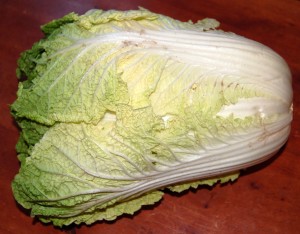
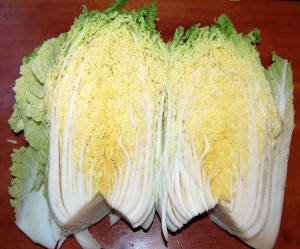
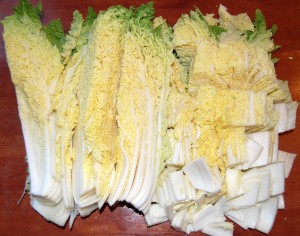
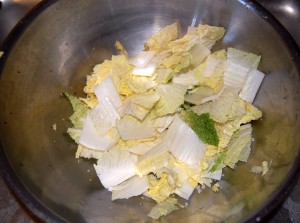
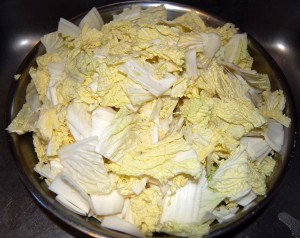
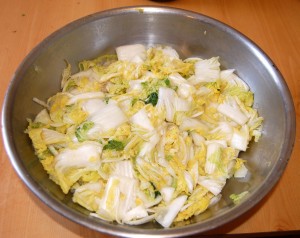
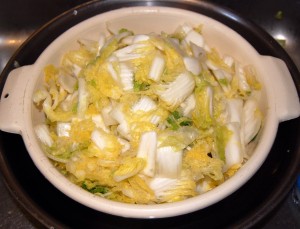
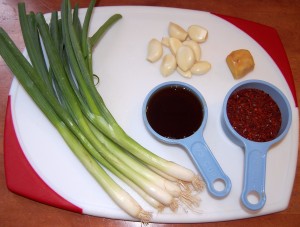
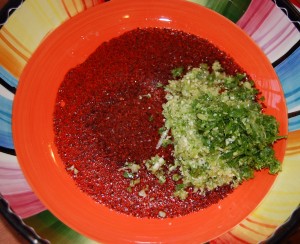
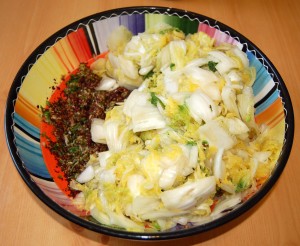
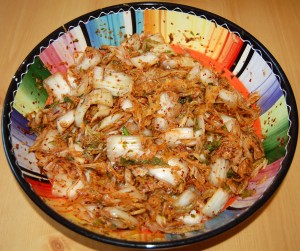
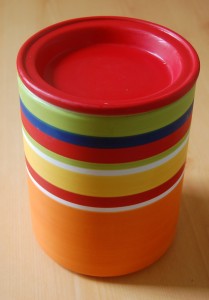
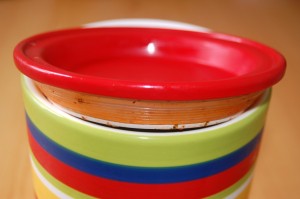
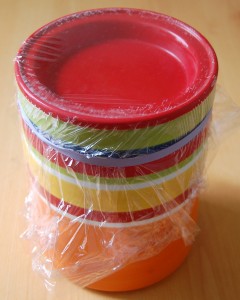
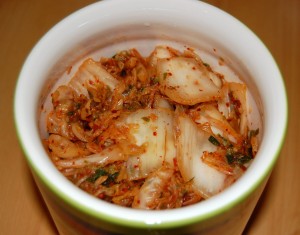
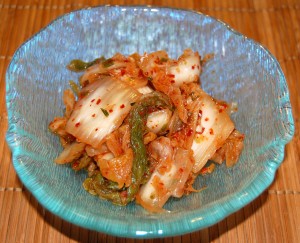




This looks really good. I’m a bit afraid of fermenting things at home though. I tried once and it was disastrous. I think I’ll have to try again.
Paul,
This looks so easy. Just curious – how long should the fermentation process run before the kimchi is “done”? I imagine the fermentation process is temperature-dependent.
great recipe!
take a look at the body ecology website! http://www.bodyecology.com
they have a ton of fermented food recipes. also, lots of information about why fermented foods are so healthy. good bacteria have made a huge difference in my energy and digestion. i will give your kimchi recipe a try!
wow, how ironic – i just made kimchi yesterday! i’ll have to try this method, since mine always turns out more watery than i’d like. do you think the ceramic makes a difference? because i just use regular old mason jars!
there are so many different methods of making kimchi, and so many different ingredients you can use, there’s definitely a recipe for every palate.
Hi cipher,
You can eat it right from the beginning, but the number of bacteria grows with time. Eventually, yeast/fungi will grow and it shouldn’t be eaten, or should be boiled first in a stew. You can tell by smell when it’s going bad.
I think any time in the first two weeks is fine. It may last longer, we finished our first batch too quickly to tell.
In Korea, traditional kimchi kept in sealed jars outdoors could last the winter.
Thanks, Megan!
Nicole, we probably would have bought Mason jars if we’d seen them, but these ceramic ones were available and work just fine.
Cipher,
I’ve been making kimchi every week for 2 years now. I have found a 6 day ferment works perfect for nappa cabbage. I also use 1/2 tablespoon of sea salt for every pound of veggies.
http://criticalmas.com/2011/03/kimchi-101/
Paul,
Thank you – I bet you ate the cookie dough before all the cookies were baked when you were a kid 😉
MAS,
Thank you for for the timeline and link.
Hi cipher,
Of course, cookie dough is much tastier than cookies!
I’m anxious to get started but there are two things I’d like you to clarify. 1) Are you using sea salt? (I have lots of celtic salt on hand) and 2) you say wash the cabbage in the end to remove most of the salt. Isn’t it the salt that keeps the fermented veggies from going bad?
I’ve been making sauerkraut (with lots of salt) and after 10 days or so put it into the fridge where it keeps for quite a long time (if not eaten).
@rhc –
1- Sea Salt is perfect. Celtic or Redmond both work well.
2- Doing a rinse of the salt is optional. Supposedly letting it sit with the salt for a hour is enough to trigger the fermentation. However, most of the recipes that recommend a rinse tend to start with either a brine or they advise higher levels of salt.
I prefer use a low amount of salt (1/2 tablespoon per pound) and then not rinse. Another trick you can do to jump start the ferment is to take a little bit of the juice from the previous kimchi and add it to the mix. This would in theory allow for even less salt, but I have not dialed in exactly how much less.
For green cabbage (sauerkraut), I extend my ferments out to 3.5 weeks.
Thanks, MAS, great reply. Nice blog too.
rhc, yes, you should also use sea salt. The purpose of salt is two-fold, to extract water and to get the fermentation started with a good mix of species. The original salt treatment and rinse helps to remove undesirable bacteria and fungi. Too much salt in the post-rinse fermentation would be antimicrobial and, while it would make the vegetables last a long time, would also hinder the fermentation and alter the mix of species. Using a lot of salt at first and then rinsing helps extract water and gives a less watery kimchi.
MAS’s method is OK but will probably produce a somewhat more watery kimchi. Some of the probiotic bacteria may be lost into the water.
Best, Paul
Paul,
I’ve tried different salt methods and really the wonderful thing about kimchi is they all seem to work. I got my current ratio from a member of my local WAPF group that interviewed a group of people that won ferment competitions.
Have you had a chance to look into the kimchi scare article that came out on June 1st? I’d be interested to hear your thought.
http://www.slate.com/id/2295964/?gt1=38001
Hi MAS,
I saw that. There are definite links between fungi and cancer – I’ll blog about that later – and fungi are most common in sugary kimchis and older kimchis. A lot of store kimchis add sugar so that overnight fermentation is enough, but these will go bad quickly. Also, Asians tend to tolerate sour flavors much better than Americans and will eat old kimchi.
Salt and stomach cancer is the other concern, but we keep salt levels relatively low and although we eat kimchi daily, we don’t eat huge quantities. I’m not concerned.
I’m not worried about our homemade kimchi but I do have a bias toward eating fermented vegetables when they’re relatively fresh. Fungi grow much more slowly than bacteria but they ultimately triumph in any fermentation process.
Thanks Paul,
What a great step by step guide. I always liked kimchi but rarely eat it since I can’t take the heat:))
I was wondering would it be okay to minimize or eliminate cayenne pepper to suit my taste?
(I know, I know… but I just don’t like spicy food, what can I do 🙂
Hi Mia,
Yes, of course, there’s no need for cayenne pepper. You have to remember we have two people in our household who grew up in Korea. They moderate the recipe for me.
This is good news 🙂
I’ll give it a shot then.
Thanks Paul.
I’m Korean and I’ve tried a lot of kimchi in my lifetime. Yours seems very simple. My mom makes many different kinds, multiple times a year. She buys 3 gigantic boxes of cabbage 2-3 times a year and kimchi-making is a 2 day event. Every family has a different recipe that gets passed down through generations and get changed a little each time.
Some suggestions:
1. Don’t use fish sauce. I don’t know what kind you’re using, but all the bottles I’ve seen have some not so great ingredients. Use “saewoo-jut” (google for images), which are tiny little shrimp in salt, comes in jars. You can’t see shrimp in the final product. I don’t know a single Korean family who uses fish sauce, they all use the shrimp thing.
2. Grind up some asian pears to add to it. It adds a slight sweetness and more depth of flavor.
3. After discarding the outer layers of the cabbage, just cut in half and salt/dehydrate the cabbage in halves.
4. While some people cut the cabbage into pieces first and then mix it into the bowl of spices, I think it tastes better when you leave the cabbage in halves. Then spread the spices onto each layer of leaves. Ferment them in big large tupperware and cut them when they’re done before serving.
5. Also get one of those big white radishes (“moo” in korean) and grate it into the spice mixture. Can’t believe I forgot about this step.
Also, the cayenne pepper you find in grocery stores and the red pepper powder/flakes that you find at Korean grocery stores are very different.
Thanks, Jeanna! We’ll try it your way. Our recipe came from our Korean sister-in-law and is also, we believe, widely used in Korea. It’s better suited to making a smaller quantity of kimchi for household use, and also simpler which I think is important. Re the fish sauce, it’s a fine ingredient as long as you get one without MSG. Although traditionally kimchi was made with raw fish, on our last visit to Korea we saw lots of fish sauce offered in markets for people making kimchi, and Wikipedia considers it one of the five most common ingredients: http://en.wikipedia.org/wiki/Kimchi#Main_ingredients.
Best, Paul
Hi Paul,
You wouldn’t believe how hard it is to get beef fat to render. We have no Asian market. I just went to a butcher friend who made the same complaint, not enough beef fat to make hamburger for his customers. Instead he gave me a huge chunk of veal fat. He said veal fat doesn’t have any fiber so it wouldn’t do for making hamburger. Will veal fat be a substitute for beef fat?
Steve
Hi stephen,
Yes, veal fat is great.
I made a pickle using a variation on your kimchi recipe. Its not entirely PHD compliant but it marries the traditional pickles in Northern India with the concepts in your recipe.
I used beetroot, carrot, and radish, for the pickle. After removing water I added onions ginger/garlic paste and chili. In addition I used a small amount of oil from an older pickle. Our traditional pickles use a lot of mustard oil. This one was from a pickle made with large red chilli.
The end result was really awesome. We still have not put the pickle in the fridge after 10 days, and it is holding great at room temperature here in Bangalore around 25C.
I made yesterday a fresh batch from normal cabbage. Lets see how this one comes out.
Traditionally our pickles are made using lots of mustard oil and put in the sun, covered with muslin cloth. These pickles last years if properly done. The difference we did was to use much less oil, and stored it in a sealed container and no sunlight.
Thanks for the recipe.
Hi, Paul-
I made your kimchi last weekend and let it ferment all week. I just tried it today and it’s very tasty! (I make frequent trips to South Korea and enjoy it there…I have to say that this is on par!) I do need to adjust the fish oil and pepper a bit — I make a smaller batch (only about 1 lb of cabbage) so this is just a BIT spicy!
My only suggestion is that you link this to your “Recipes” page…you have an entry there for kimchi but not this recipe. I happen to stumble upon it through the recipes over on Dan’s PLan — I think plenty of PHD followers would enjoy it
Jim
Hi Jim,
Actually, this recipe is on the Recipes page — as “Homemade Kimchi”, June 26, 2011. I’ll add an update to the Kimchi post so people know to look there.
Ahh…if only I had mastered the skill of reading for comprehension! 😉
Thanks!
I just made my second batch of kimchi. The first one seemed to turn out right, but I just didn’t like the fish flavor. I didn’t know what to substitute so I used some raw coconut aminos. Was that ok?
Yes. It’s not necessary to use fish sauce if you don’t like the flavor. Coconut aminos are fine but aren’t necessary either.
This looks delicious.
We usually do our kimchi fermentation in large, kitchen-use zip-lock bags. Its really simple to squeeze out nearly all the air before pinching the seal shut, to discourage aerobic bugs from proliferating. Also you can easily flip over or slightly massage the bags a bit to keep things mixed around more evenly during the first couple of days of fermentation. For storage both during fermentation and while consuming, just place the bags in a bowl or bread pan or something in case of leakage. When done, turn the bags inside out, wash with soapy water, rinse and dry in sun for an hour or so, and you can get several re-uses.
Great idea MH.
Hi Paul
I always upset my family when I open my jar of kimchi. After the initial few days of fermentation I transfer the jar to the fridge but when I open it up to pop a little onto my plate it releases a very pungent aroma. My children are particularly aghast whenever I do this as the smell really offends them. Is this normal (I mean the smell, not the children’s reaction)? It still tastes fine to me, quite acidic and spicy, do you think it’s still safe to eat? I have kept my kimchi in the fridge for up to a month or so. (This latest batch consists of Chinese leaf, carrot, radish, chilli, salt, ginger and a little fish sauce).
Hi Liz,
If it’s acidic and tastes fine to you, it is probably good. The main failure is to mold, which will form a white layer on top; or to insufficient acid – you want the lactic acid producing species to turn the salt into sour flavor.
You could try taking the vegetables out and serving them without the sour brine, and also diluting them with other foods — mix them with meat, starch, and other vegetables.
We typically eat kimchi between days 4 and 7. It does keep much longer in the refrigerator but will still go bad eventually.
Hi Paul,
I’m so looking forward to trying this! In fermenting do you recommend using iodized salt or non-iodized?
Thanks!
Hi I just made my first kimchi ever but after mixing all the ingredients I realised I forgot to salt the cabbage. What should I do. Can I still each my kimchi? Please help. Thanks
I think that means you’ll just have a soupy/watery kimchi. It will still be edible.
Thanks so much for your reply.
Hello,
I made kimchi on the counter but overfermented it. For some reason I thought it needed a month. There was a touch of white mold/fungus around the rim of the jar. I threw away the top layer of kimchi and tried a piece. It didn’t taste bad at all but im nervous about eating any more. How can you tell if it’s unsafe to eat?